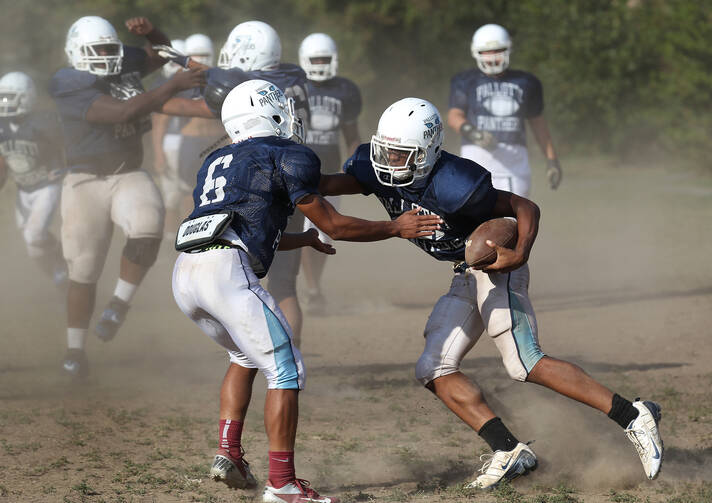The second week of December was a rough one on the home front. The Washington Post told us that beyond the massacre at Newtown, 71 children had been killed by gunfire in 2012. In Colorado, a high school student armed with a just-bought shotgun set out to get even with one of his teachers, but shot two students and killed himself. In New York, a fraternity took a pledge to a distant house in the country and, in the course of bouncing him around blindfolded, killed him.
But the story that I can’t shake is about a Boston College junior on the football team, Spenser Rositano, who on October 12, during the Clemson game, sat in the locker room with his head throbbing and blood bubbling up in his mouth because of lung contusions sustained in the first half. He had a blank look on his face. It wasn’t clear if he knew where he was.
This had happened five times before, three while playing football in high school and three at Boston College. Before, the symptoms had eventually gone away. This time the headaches and dizziness went on for three weeks. He was beginning to think that maybe he had kept playing football for too long. According to Post reporter Brandon Parker, a recent NFL-funded report said that between 1.6 million and 3.8 million sports and recreation-related traumatic brain injuries, including concussions, occur every year. Furthermore, once the player has one, he is likely to have more, and the recovery time gets longer with each one. Shortly before his 21st birthday, Spenser quit.
During high school he had not always admitted the symptoms; it was at Boston College that helmet-to-helmet hits had brought on dizziness, the sensation of walking in a fog, a dream-like state. In the Army game a hit sent him into the air; but he can’t remember it. The doctors informed him that there is not much one can do about these symptoms. To play cautiously was contrary to his nature, it would not be playing his best; and he knew from his reading that it could be 30 years before he would know the full extent of his injuries.
The tone of the Post’s coverage was supportive and I was relieved that the wisdom of parents, friends and coaches helped guide him to quit.
But why did it take so long? The NFL and a whole series of independent medical institutions have been studying the effects of concussions for over 20 years. Some results were contradictory, but the evidence of harm seems overwhelming. Thousands of former NFL players have filed lawsuits, including a 2011 complaint which argued that NFL should have know that players who sustain head injuries risk “early onset of Alzheimer’s Disease, dementia, depression, deficits in cognitive functioning, reduced processing speed, attention and reasoning, loss of memory, sleeplessness, mood swings, personality changes, and the debilitating and latent disease known as Chronic traumatic encephalopathy (CTE).” Months later three retired players killed themselves, two with shotguns.
According to a Frontline report (Oct. 31, 2013), most Americans were aware that football could cause long-term brain damage, but only one in three said this knowledge would make them less likely to let their son play. The report found a “culture among athletes” that resists self-reporting of the damage. They say the game is more important than their individual health and that “they may play through a concussion to avoid letting down their teammates, coaches, schools and parents.”
Apparently they presume that their teammates, coaches and parents all agree that the game is more important than the future lives of any of these young men. If that is so we might as well be back in ancient Rome yelling thumbs down for some blood-spattered gladiator.
As Ken Reed points out in the Huffington Post (Oct. 23, 2013), 20 percent of high school football players sustain brain injuries in any given season. “It’s a classic case of avoidance behavior. As a nation, we love football and don’t want to deal with the giant elephant in the room: football is a game that’s inherently dangerous to the human brain, and there’s really not much we can do about it. Football is our great escape. It’s fun. It’s entertainment. We don’t want reality to intrude.”
Under these circumstances it is also immoral. Where are the pro-life preachers, the ethicists? There is a strong argument that high school football should be outlawed and that no one with a brain injury should be permitted to play college football. Let us entertain ourselves with soccer, basketball, track and swimming — as well as reading and working. Life is too short and precious to wreck a young man’s brain.








